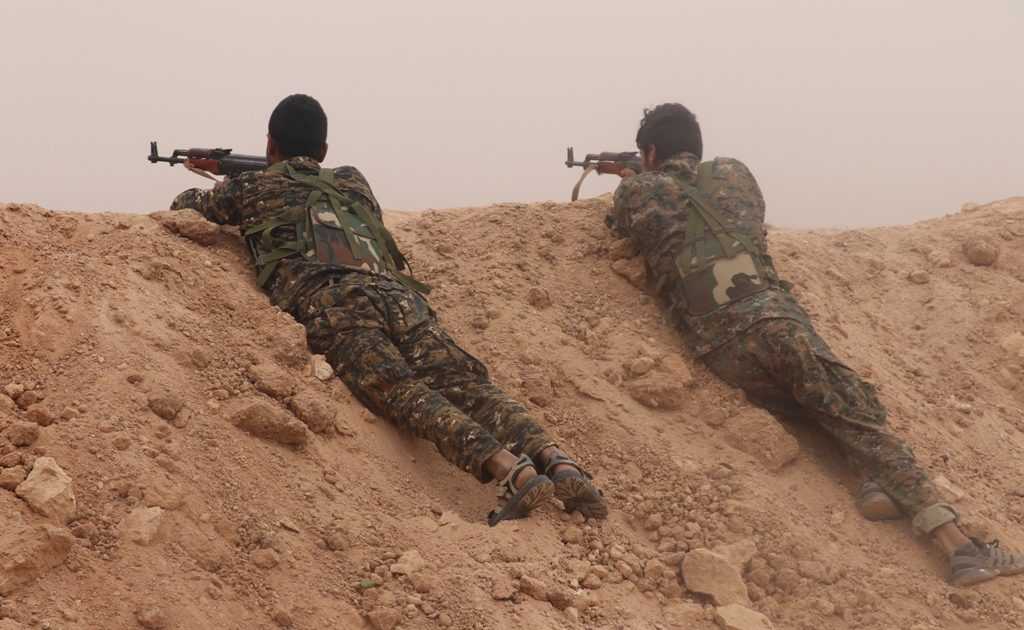SDF vows ‘definitive end’ to anti-IS offensive in Deir e-Zor after major setback
SDF fighters clash with IS near Hajin earlier this year. […]
29 October 2018

AMMAN: Syrian Democratic Forces commanders have vowed to retake ground lost to Islamic State fighters around the hardline Islamist group’s last foothold in Syria, following a major assault by Islamic State fighters over the weekend that saw the group seize a key town near the Iraqi border.
“Significant preparations [are taking place] to restart the campaign and to advance again and retake the points that Daesh has taken control of from our fighters,” Leilawa al-Abdullah, a spokesperson for the SDF-administered Deir e-Zor Military Council said, using an Arabic acronym for IS.
“The campaign will continue until the presence of IS mercenaries comes to a definitive end,” she told Syria Direct.
On Friday, Islamic State (IS) fighters launched a major counter-attack offensive against the US-backed Syrian Democratic Forces (SDF) in an area of eastern Deir e-Zor province known as Hajin, breaking through frontlines to reach the Syrian-Iraqi border.
Hajin, a once densely populated pocket of territory along the Euphrates River, is the last IS-held foothold in Syria after simultaneous military offensives by Turkish-backed rebel fighters, US-backed Kurdish-majority forces as well as the Syrian government and its allies systematically routed IS forces from their territory throughout the country since 2015.
According to the Syrian Observatory for Human Rights (SOHR) monitoring group, 72 SDF fighters were killed in attacks since Friday.
However, SDF sources have downplayed those figures.
Al-Abdullah told Syria Direct on Monday that a “number of fighters have been martyred” in clashes over the weekend, without elaborating further.
In the wake of the IS counter-attack, SDF commanders and officials have vowed to restart their campaign—reportedly bolstering forces in the area with reinforcements of fighters and commanders.
According to one SDF commander, speaking on condition of anonymity because he was not authorized to speak to press, since the weekend’s attacks the Kurdish-majority force has “decided to replace fighters and forces [in the area] with the YPG,” following “major breakthroughs” by IS fighters since Friday.
“The YPG will counter-attack [on Monday] to return the fronts to their control,” the commander added.
Col. Sean Ryan, a spokesperson for the US-led coalition that backs the SDF, acknowledged that IS was “able to gain some ground back” since Friday “but overall they have been on the defensive for months.”
“ISIS is using experienced foreign fighters with nothing to lose and the SDF will come back with coalition support and continue to degrade and destroy ISIS,” he told Syria Direct via email on Monday.
The SDF, backed by warplanes from the US-led international coalition, launched an offensive on IS positions in and around Hajin on September 10, officially announcing the campaign the following day.
Now in its second month, that offensive has been slowed by inclement weather conditions, including sandstorms, and networks of IS tunnels in the area.
And although the SDF had made incremental progress against the last remaining IS foothold in Syria, seizing the strategic town of Sousah last week, the sudden collapse of SDF frontlines has left residents fearful for what may come next.
“Explosions seem to happen every day,” local media activist Ayman al-Alaou told Syria Direct on Monday, citing local fears of “assassinations, kidnappings of civilians by IS as well as a situation of chaos unleashed on all of the SDF areas in the eastern [Deir e-Zor] countryside.”
“The situation is uncomfortable for us,” he added.
“After [IS] advanced, the security situation in the towns of rural eastern Deir e-Zor is very poor.”
In recent weeks, coalition airstrikes on local mosques have reportedly killed civilians and IS fighters alike. One airstrike earlier this month killed as many as 60 civilians in a Sousah mosque, according to UK-based monitoring group Airwars.
Coalition spokesman Col. Sean Ryan has insisted that the mosques are being used by IS fighters as “command and control centers” for counterattacks.
Local residents, however, are “clear that non-combatants, including women and children, are also being killed in significant numbers,” Airwars director Chris Woods told Syria Direct via email.
At IS’ peak in 2014, the hardline group occupied vast swathes of territory stretching across Syria and Iraq roughly equivalent to the size of the United Kingdom.
Today, IS controls roughly one percent of its former territory and has largely retreated into the sprawling deserts of Iraq and eastern Syria.
The hardline Islamist group has meanwhile carried out a number of assaults on civilian and military targets in Syria in recent months—most notably a devastating attack on Suwayda city and two villages in southwestern Syria’s Druze-majority Suwayda province that left hundreds dead.
With additional reporting by Avery Edelman and Alice Al Maleh.







